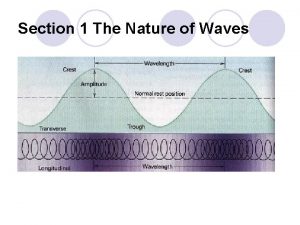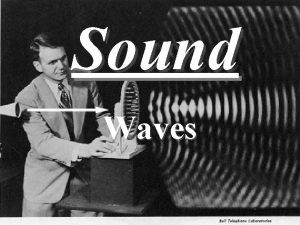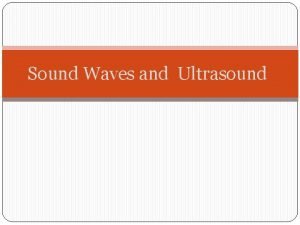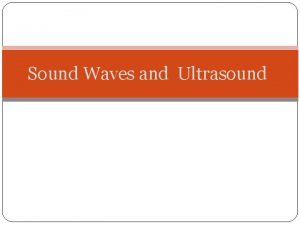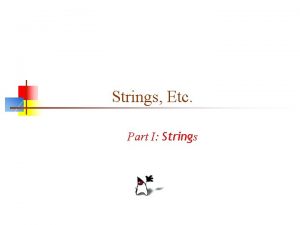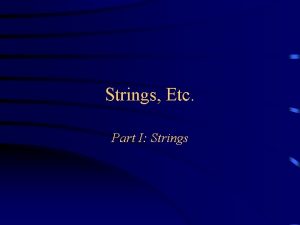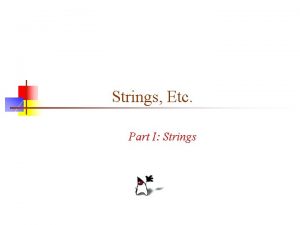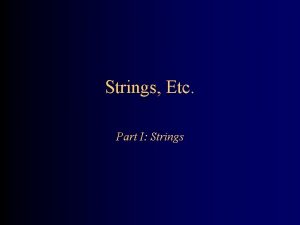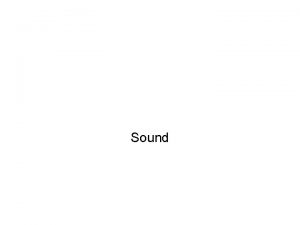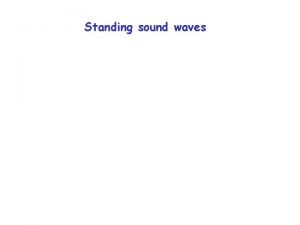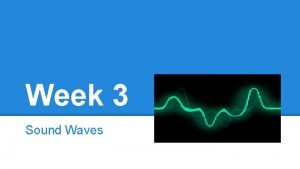Wave II 1 Sound Waves on Strings etc
















- Slides: 16

Wave - II

1. Sound Waves on Strings, etc. : Transverse Waves Sound Waves: ANY Longitudinal Waves These are material waves.

y(x, t) = ymsin(kx-wt) Transverse wave Wave Function s(x, t) = smcos(kx-wt) s: The displacement from the equilibrium position The sin and cos functions are identical for the wave function, differing only in a phase constant. We use cos in this chapter. sin(q+90˚)=cosq

Pressure Amplitude ∆p(x, t) = ∆pmsin(kx-wt) ∆p: the pressure change in the medium due to compression (∆p >0) or expansion (∆p <0) ∆p(x, t) and s(x, t) are 90˚ out of phase

Bulk modulus 2. Wave Speed Transverse Waves (String): Tension elastic Linear density inertial Sound Waves (Longitudinal Waves): Bulk modulus Volume density elastic inertial

Bulk Modulus

3. Intensity Transverse Waves (String): Sound Waves (Longitudinal Waves): A: area intercepting the sound

Wavefront, Ray, and Spherical Waves Wavefront: Equal phase surfaces Spherical: spherical waves Planar: planar waves Ray: The line wavefront, that indicates the direction of travel of the wavefront At large radius (far from a point source): spherical wavefront planar wavefront

Sound Intensity for a Point Source Wavefront area at distance r from the source: A = 4 pr 2

The Decibel Scale The sound level b is defined as: decibel 10 -12 W/m 2, human hearing threshold

4. Interference For two waves from two different point sources, their phase difference at any given point depends of their PATH LENGTH DIFFERENCE ∆L x x+l f = 0: constructive f = p: destructive other: intermediate kx kx+2 p

Constructive: m=0, 1, 2, . . . Destructive: f = 0: constructive f = p: destructive other: intermediate f = m(2 p), m=0, 1, 2, . . . f = (m+1/2)(2 p), m=0, 1, 2, . . .

Standing Waves in a Tube BOUNDARY CONDITIONS: Closed End: s = 0, a node for s ∆p = ∆pm, an antinode for ∆p Open End: s = sm, an antinode for s ∆p = 0, a node for ∆p

HRW 9 P (5 th ed. ). A man strikes a long aluminum rod at one end. A woman at the other end with her ear close to to the rod, hears the sound of the blow twice (once through air and once through the rod), with a 0. 120 s interval between. How long is the rod? Let the length of the rod be l, the speed of sound in air be v 1, and the speed of sound in the rod be v 2. The time interval between the two sounds: Solve for l:

HRW 18 P (5 th ed. ). The pressure in a traveling sound wave is given by the equation ∆p = (1. 5 Pa) sin p[(1. 00 m-1)x - (330 s-1)t]. Find (a) the pressure amplitude, (b) the frequency, (c) the wavelength, and (d) the speed of the wave. ∆p(x, t) = ∆p msin(kx-wt) s(x, t) = smcos(kx-wt) (a) ∆pm = 1. 5 Pa (b) f = w/2 p =(330 s-1)/2 =165 Hz (c) l=2 p/k = 2 p /(1. 00 m-1) p=2 m (d) v = lf =330 m/s

HRW 23 P (5 th ed. ). Two point sources of sound waves of identical wavelength l and amplitude are separated by distance D = 2. 0 l. The sources are in phase. (a) How many points of maximum signal lie along a large circle around the sources? (b) How many points of minimum signal? The phase difference at point P: (a) Maximum: ∆f=2 mp sinq = m/2 (m=0, ± 1, ± 2, …) Eight: 0˚, 30˚, 90˚, 150˚, 180˚, 210˚, 270˚, 330˚ (b) Eight, in between the maximums.
 Characteristics of a longitudinal wave
Characteristics of a longitudinal wave Whats a reflected sound wave
Whats a reflected sound wave Sound is a transverse wave true or false
Sound is a transverse wave true or false Differences between mechanical and electromagnetic waves
Differences between mechanical and electromagnetic waves Rate of energy transfer by sinusoidal waves on strings
Rate of energy transfer by sinusoidal waves on strings Compare and contrast p waves and s waves using venn diagram
Compare and contrast p waves and s waves using venn diagram An example for mechanical wave
An example for mechanical wave Mechanical and electromagnetic waves similarities
Mechanical and electromagnetic waves similarities Constructive
Constructive Venn diagram of mechanical and electromagnetic waves
Venn diagram of mechanical and electromagnetic waves Long waves and short waves
Long waves and short waves Surface waves and body waves
Surface waves and body waves Difference between matter waves and electromagnetic waves
Difference between matter waves and electromagnetic waves Is a seismic wave mechanical or electromagnetic
Is a seismic wave mechanical or electromagnetic Low amplitude wave
Low amplitude wave Mechanical vs electromagnetic waves
Mechanical vs electromagnetic waves Ability of two or more waves to combine and form a new wave
Ability of two or more waves to combine and form a new wave
















